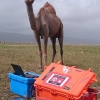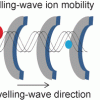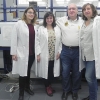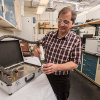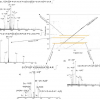News
Mass Spectrometry News
Cathy Costello is the 2017 Recipient of the ASMS Award for a Distinguished Contribution in Mass Spectrometry, which recognises a singular significant achievement.
A group of scientists from EAWAG, the Swiss Federal Institute of Aquatic Science and Technology, have developed a portable mass spectrometer allowing on-site measurements, and a spin-off has been created to commercialise the new system.
Quantum mechanics dictates how particles and forces interact, and thus how atoms and molecules work, for example, what happens when a molecule goes from a higher-energy state to a lower-energy one. But beyond the simplest molecules, the details become very complex. Now, a Pixel-Imaging Mass Spectrometry camera and a femtosecond vacuum ultraviolet light source are showing how does quantum mechanics work in larger, more complex systems.
Salmon is one of the most popular edible fish of all. Shops sell fish caught in the wild, but their main produce is salmon from breeding farms, the effluent from which can pollute rivers, lakes and oceans. German and Chilean scientists have used fluorescence measurements, high-resolution mass spectrometry and nuclear magnetic resonance spectroscopy to answer this question.
Drugs containing gold have been used for centuries to treat conditions like rheumatoid arthritis. In addition, they can be effective against cancer and HIV. One mechanism by which they work could occur because gold ions force the zinc ions out of zinc fingers—looped, nucleic acid binding protein domains. American researchers have characterised such “gold fingers” using ion mobility mass spectrometry and identified the exact gold binding sites.
By measuring the height profile of the sample prior to analysis, mass spectrometry imaging can now visualise the distribution of chemical substances on samples with non-flat surfaces.
SIFT-MS has shown promising results for the detection of cancers of the oesophagus and stomach in a large patient trial presented at the European Cancer Congress 2017.
Scientists from the universities of Oxford and Manchester, UK, have used a mass spectrometry molecular fingerprinting technique to identify one Neanderthal bone from around 2000 tiny bone fragments.
University of Alabama at Birmingham, USA, researchers have made a microscopic snapshot of the early renal lipid changes in acute kidney injury, using matrix-assisted laser desorption/ionisation (MALDI) tissue imaging to localise the changes.
At a ceremony at the University of Copenhagen, Waters officially welcomed the University’s Forensic Chemistry Laboratory within the Department of Forensic Medicine into the Waters Centers of Innovation Program.
New UK laboratory provides access to analytical technologies to help strengthen modern life and health sciences research.
We are all probably aware of the detection of metabolites in wastewater to indicate the levels of illegal drug usage in a locality, but researchers at the University of Valencia have extended this to monitor alcohol consumption in near real time.
The US Department of Energy’s Oak Ridge National Laboratory and Sciex of Framingham, MS, USA, have signed a licensing agreement for technologies that speed up, simplify and expand the use of mass spectrometry instrumentation.
A chemist at the National Institute of Standards and Technology (NIST) has developed a portable version of his headspace method for recovering trace chemicals such as environmental pollutants and forensic evidence including secret graves and arson fire debris.
Medical testing has been undergoing a quiet but extensive metamorphosis as labs adopt the versatile technology mass spectrometry, which enables more precise diagnosis. A special issue of Clinical Chemistry, titled “Clinical Mass Spectrometry: Achieving Prominence in Laboratory Medicine”, showcases recent medical advances that this technology has made possible.
A new test for detecting biomarkers for cancer and diabetes based on two-dimensional mass spectrometry is more than 1000× more detailed and 100% faster than existing methods, new research by the University of Warwick, UK, suggests.
Mass spectrometry-based proteomic analysis matches bullets to wounds using organ-specific protein signatures found on projectiles.
A new study led by scientists at The Scripps Research Institute (TSRI) shows that gas chromatography mass spectrometry fundamentally alters the samples it analyses.
Agilent Technologies has announced the opening of a new centre for life science research in partnership with Carleton University in Ottawa, Canada. The Carleton Mass Spectrometry Center, located in the university’s department of chemistry, is equipped with state-of-the-art mass spectrometers, gas and liquid chromatography systems, and bioinformatics tools from Agilent. It will be an analytical resource for researchers and industrial partners across Canada.
Collaboration to produce commercially available assays that quantitatively measure phosphorylated and unmodified proteins known to be involved in cancer signalling pathways.


